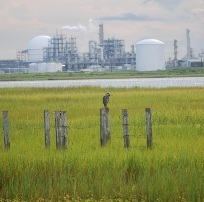Following up on a previous review of the state of Chesapeake Bay water quality trading, come two different legal moves regarding the Chesapeake Bay. Lawyer up.
Photo source: Flickr chesbayprogram
1. Agricultural and Homebuilding Groups Challenging the TMDL
The first legal move that could affect water quality trading was a day in court for agricultural and residential development interests wanting to block the Bay’s Total Maximum Daily Load (TMDL) to improve water quality. TMDLs establish a line-in-the-sand that is the basis for water quality trading programs. Without it, no trading. Oh, and no (or limited?) enforceable water quality rules. The two groups’ legal challenges both came back in 2011, with the agricultural groups filing suit in January and the homebuilders’ group filing suit in June. If I can boil down the arguments, they were that 1) the EPA exceeded their authority, and 2) the way the EPA spread the blame of where pollution came from and who had to clean it up was not accurate/fair. The EPA defended itself, and noted that
“…the Bay states asked the agency to set the TMDL, and the schedule for its creation was established in a court settlement with environmentalists [sued in 2009, settled in 2010]. Further, the officials argued that EPA is owed deference in areas where the CWA is not explicit, such as how to address the impairment of a multistate waterbody.” (source)
So what happened on that day in court (Oct. 4th, U.S. District Court for the Middle District of Pennsylvania)? District Judge Rambo heard arguments for four hours. Some key snippets from Baltimore Sun coverage:
Critics contend the EPA is using the plan to force states to regulate runoff from farms and other lands, which Congress never authorized the agency to do.
“If they can do it here, they can do it anywhere, on any scale,” said Don Parrish, a spokesman for the American Farm Bureau Federation… “We’re not saying we don’t want to clean up the water, or that states can’t do it,” he added. “We’re saying that EPA can’t do it and can’t force states to do it.”
—
Kent F. Hanson, a Justice Department lawyer for the EPA, said federal regulators worked closely with state officials in a years-long, open process to develop the pollution-reduction plan. While some states did resist and complain about the EPA’s handling of it, he noted that none joined in the farmers’ and builders’ lawsuit.
The ruling still hasn’t come down as of October 19th, but I’ll keep my eye out for it and update this when news comes through.
2. Environmental Groups Challenging the Use of Water Quality Trading
The second legal move says, we like the TMDL, we just don’t like water quality trading. Environmental groups Food & Water Watch and Friends of the Earth filed suit on October 3rd to drop water quality trading as an option for meeting Bay water quality improvements. What’s their beef with water quality trading? Their press release uses a lot of loaded words to indicate that trading makes them feel icky (see Spinning Water Quality Trading: Pros and Cons). More specifically, the lawsuit alleges that water quality trading:
…contravenes EPA’s authority and duty under the Clean Water Act (“CWA”), 33 U.S.C. § 1313(d)(1)(C), is arbitrary and capricious in violation of the Administrative Procedure Act, 5 U.S.C. § 706(2)(C), and violates notice and comment required by the Administrative Procedure Act, 5 U.S.C. § 553.
[My non-legal take on] The core of their argument is that a point source using a water quality credit can violate their permit, and that’s what is illegal. No doubt the case will take time to get through the system, but it looks like some environmental groups have decided that this is the opportunity to take a stand against something repugnant… which reminds me of a great Freakonomics podcast: “You say repugnant, I say let’s do it.”
Round II of a Chesapeake Bay Water Quality Trading Update…
So it looks like there’s a few fundamental stumbling blocks for water quality trading in the Bay. Namely, that major stakeholders think the fundamental rules (TMDLs) are bunk, and other stakeholders want to strike trading off the menu. What if they both prevailed? I guess that would leave business-as-usual: States responsible for meeting water quality deadlines, and reliance on treatment technology (which wastewater treatment plants have said they’ve maxxed out). Oy. Good times in the Bay.











